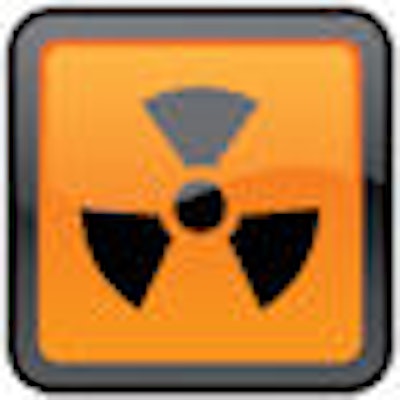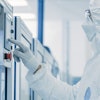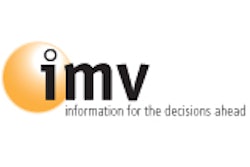
The U.S. population's exposure to ionizing radiation from medical procedures grew more than sevenfold between the early 1980s and 2006 -- an increase largely attributable to spectacular growth in the use of CT, according to a new report released today by the National Council on Radiation Protection and Measurements (NCRP) of Bethesda, MD.
The increase in radiation exposure was due mostly to the higher utilization of CT and nuclear medicine, said Kenneth Kase, Ph.D., NCRP senior vice president and chair of the committee that produced the report, which was released in conjunction with the NCRP's annual meeting on March 2 and 3 in Bethesda.
"These two imaging modalities alone contributed 36% of the total radiation exposure and 75% of the medical radiation exposure of the U.S. population," Kase said in a statement accompanying the report's release.
The report found that in 2006 the U.S. population of 300 million individuals received a collective effective dose from medical radiation of 899,000 person-Sv and an effective dose per individual of 3 mSv. That compares to a collective effective dose of 123,700 mSv and an effective dose per individual of 0.53 mSv in the early 1980s.
The number of CT scans and nuclear medicine procedures performed in the U.S. during 2006 was estimated to be 67 million and 18 million, respectively. In contrast, only an estimated 18.3 million CT exams were conducted in the U.S. in 1983, the report stated.
The 2006 results show a marked increase (by a factor of 7.3) in the collective effective dose over 25 years, with a corresponding 5.7 effective dose increase per individual in the U.S. population, the authors wrote. (The report did not include dose from radiation therapy and other specialized imaging procedures -- see chart below.)
The following chart shows the annual effective dose per individual for a variety of medical imaging procedures from the early 1980s to 2006:
|
||||||||||||||||||
| Data does not include radiation dose from radiation therapy, PET/CT, SPECT/CT, CT/fluoroscopy, and interventional applications. Data from the National Council on Radiation Protection and Measurements, "Ionizing Radiation Exposure of the Population of the United States," March 3, 2009, table 4.19. |
Background radiation accounted for 3.1 mSv of effective dose per individual in 2006, compared to 3.0 mSv in the early 1980s, the report stated.
Medical sources of radiation in 2006 resulted from:
- CT - 49%
- Nuclear medicine - 26%
- Interventional fluoroscopy - 14%
- Conventional radiography and fluoroscopy - 11%
CT dose booms
The report blamed skyrocketing CT use as the main factor contributing to rising individual dose.
"Technological advances in CT and the ease of use of this technology have led to many clinical applications that have increased the use of CT at a rate of 8% to 15% per year for the last seven to 10 years," they wrote. The report cites data from market research firm IMV Medical Information Division of Des Plaines, IL, indicating that the number of MDCT scanners in the U.S. increased from nearly 51% of total scanners in 2004 to 71% in 2006.
In 2006, the average CT exposures, taken from medical literature, included the following:
|
|||||||||||||||||||||||||||||||||
| Data from the National Council on Radiation Protection and Measurements, "Ionizing Radiation Exposure of the Population of the United States," March 3, 2009, table 4.2. |
"While the greatest growth in the number of CT procedures occurred in the late 1990s and early 2000s, the use of CT technology in the U.S. is likely to continue to increase over the next 10 years," the report stated. "Many new clinical applications are being developed; CT technology can be used with ease, perform a patient scan in a very short time ... and provide high-quality images for diagnosis."
While conventional radiography and fluoroscopy comprise the largest number of exams in the U.S., the collective effective dose from these exams represents only a small percentage (11%) of the total medical dose, the authors wrote. Migration to CT studies is responsible for a steady decline in the contribution of this category to total radiation dose.
"Some particular radiographic examinations did increase, such as mammography, which was also just becoming accepted medical practice in 1980, and chest imaging, which as a screening tool for admissions may simply reflect an increase in the number of patients in the healthcare system," they wrote. "Thus, most of the increase in [individual exposure] for medical applications represents utilization of new tools since the assessment in NCRP."
Cardiac imaging dominates nuclear medicine
Between 1982 and 2006, the estimate of radiation to individuals in the U.S. from in vivo diagnostic nuclear medicine increased by 460%, and the collective effective dose increased by 620%, the authors noted. Between 1972 and 2006, diagnostic nuclear medicine procedures increased by a factor of 5.5, while the U.S. population increased by approximately 50%. And during the past decade, there was 5% annual growth in the number of nuclear medicine procedures, while the U.S. population grew less than 1% annually, the authors reported.
"Nuclear medicine has grown steadily since the end of World War II. There has been continuing evolution of instrumentation, development of new radiopharmaceuticals, and competition with other imaging techniques," the authors wrote. In 2006, the annual number of nuclear medicine patient visits in 2005 was slightly more than 17.2 million, resulting in 19.7 million procedures performed.
Cardiac imaging alone accounted for 85.2% of all nuclear medicine radiation in 2005, whereas the next highest contender, bone imaging, contributed just 9.3% of the total radiation. Tumor imaging, at 1.8% of the total, was a distant third.
For example, a cardiac perfusion study was estimated to deliver an approximate effective dose of 12.6 mSv with the use of a technetium-99m sestamibi radiopharmaceutical and 33 mSv with the use of thallium chloride.
The report cited cardiac interventional procedures across modalities as another big source of ionizing radiation. "It is of interest to note that the cardiac procedures comprise only 28% of the total number of procedures, yet the collective effective dose is 53% of the total for all interventional procedures," they stated.
Excluding nuclear cardiology, the number of nuclear medicine procedures increased only by approximately 1,000 procedures over 24 years, while the U.S. population grew by 30%, they said.
ACR blames self-referral
Weighing in on the report, the American College of Radiology (ACR) in Reston, VA, cautioned that medical imaging provides benefits that must be carefully weighed against the risks of intervention.
"It is essential that this report not be interpreted solely as an increase in risk to the U.S. population without also carefully considering the tremendous and undeniable benefits of medical imaging. Patients must make these risk/benefit decisions regarding their imaging care based on all the facts available and in consultation with their doctors," said Dr. James Thrall, chair of the ACR board of chancellors.
The ACR said the evidence shows that in-office imaging is responsible for significant unnecessary radiation exposure, and that new laws are needed to curb self-referral by nonradiologist providers who are too quick to image and too slow to adopt dose-reduction measures.
Peer-reviewed studies "have shown that when physicians refer patients to facilities in which they have a financial interest, imaging utilization is significantly increased," the ACR wrote.
Medicare data from 1998 to 2005 show that the number of self-referred, in-office CT, MRI, and nuclear medicine scans performed grew at triple the rate of the same exams performed in all settings, the ACR stated.
"Private insurance studies indicate that as much as half of this self-referred imaging is unnecessary, in many instances needlessly exposing patients to radiation," the ACR wrote. "Provider fear of litigation, advancing technology, and patient demand may have also contributed to this increase in exposure."
The organization advocates federal standards for in-office high-tech medical imaging providers or for imaging facilities not registered as independent diagnostic testing facilities. Most nonradiologist providers receive little, if any, radiation physics or imaging training.
"Self-referral is a concern," NCRP executive director David Schauer, Sc.D., told AuntMinnie.com, citing a study that identified $16 billion wasted each year from self-referred imaging studies. Another study identified dose reductions of 44% when ACR appropriateness criteria were followed (Journal of the American College of Radiology, March 2004, Vol. 1:3, pp. 169-172; American Journal of Roentgenology, April 2006, Vol. 186:4, pp. 937-942).
Radiologists are working to lower dose and to educate elected officials, government agency staff, and referring physicians of the need for further steps toward the goal of ALARA (as low as reasonably achievable) dose levels for medical imaging.
The ACR cited a number of programs it has developed to counteract overimaging and overuse of radiation, including its imaging Appropriateness Criteria, a white paper on radiation dose in medicine, and other information available on the ACR Web site.
Meanwhile, the Alliance for Radiation Safety in Pediatric Imaging offers information on the popular Image Gently campaign, which is designed to make providers aware of opportunities to lower the radiation dose used in the imaging of children and encompasses 34 medical organizations worldwide.
NCRP faults defensive medicine
NCRP executive director Schauer told AuntMinnie.com that the role of so-called "defensive medicine" in excessive radiation exposure is every bit as important as the problem of self-referral by nonradiologists -- as evidenced in a 2008 survey study by the Massachusetts Medical Society (the full survey report is available on the society's Web site).
"They asked physicians why they were ordering exams, and they concluded that a full one-third were ordered just because they didn't want to be sued," Schauer said.
"When you talk about the philosophy of radiation protection, before you expose a person to ionizing radiation you must first justify its use by weighing the benefit to the patient with the risk," he said. Once you decide to perform an exam, the dose must be optimized to maximize the benefit and minimize the risk.
Adherence to ACR guidelines, "evidence-based criteria that in effect you might call a standard of care," he said, is key to reducing radiation exposure. In doing so, "issues like self-referral and defensive medicine may be reduced -- this is our hope," Schauer said.
The timing of the NCRP report is also interesting because the Obama administration wants to save money on healthcare -- and careful adherence to imaging standards will accomplish just that, Schauer added. The Massachusetts survey estimates a potential annual savings of $1.4 billion in that state alone.
By Eric Barnes
AuntMinnie.com staff writer
March 3, 2009
Related Reading
CT dose-reduction awareness doesn't always translate into use, February 23, 2009
Finnish study finds unnecessary pediatric CT exams, February 20, 2009
Image Gently organizers look ahead on one-year anniversary: Part 1, February 6, 2009
JAMA study finds wide variation in cardiac CTA dose, February 3, 2009
House resolution advocates lower pediatric x-ray dose, May 27, 2008
Copyright © 2009 AuntMinnie.com




















